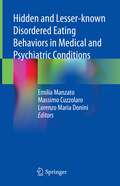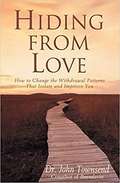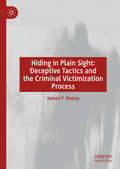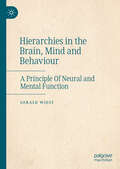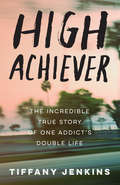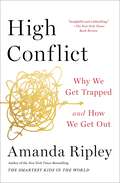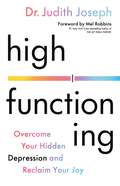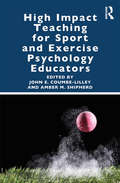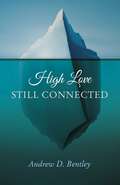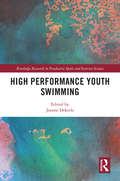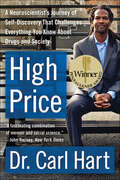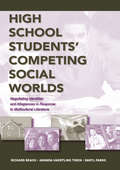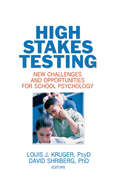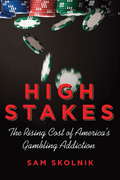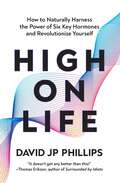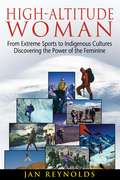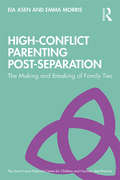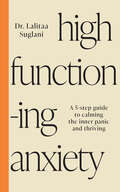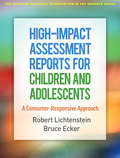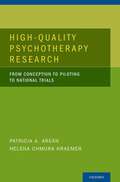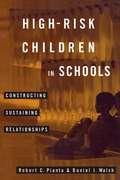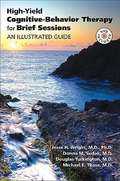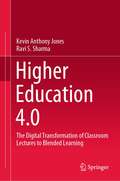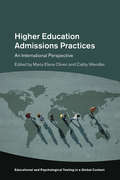- Table View
- List View
Hidden and Lesser-known Disordered Eating Behaviors in Medical and Psychiatric Conditions
by Lorenzo Maria Donini Massimo Cuzzolaro Emilia ManzatoThis book provides up-to-date information on lesser known eating disorders (EDs) and eating related disorders. EDs and eating-related disorders include a highly heterogeneous group of syndromes and symptoms characterized by abnormal eating and weight control behaviors that can appear in all genders and ages. EDs can lead to high rates of morbidity and mortality, especially if they are misdiagnosed and untreated. The risk of underestimation is high for the lesser-known ED, and when unhealthy eating behaviors appear in unusual situations, such as some medical and psychiatric pathologies, adults and the elderly, sexual minorities etc. The volume examines EDs in specific populations (the elderly, males, infants and toddlers, sexual minorities, etc.). Several chapters explore in detail lesser-known EDs (anorexia athletica, avoidant/restrictive food intake disorder, chewing and spitting, EDs by proxy, EDs after bariatric surgery, muscle dysmorphia, night-eating syndrome, nocturnal sleep-related eating disorder, orthorexia nervosa, pica, rumination disorder, etc.). Finally, other chapters address features of unhealthy eating and weight control behaviors associated with medical diseases (achalasia, craniopharyngioma, cystic fibrosis, cyclic vomiting syndrome, diabetes, dysphagia, Kleine-Levin syndrome, Klinefelter syndrome, Parkinson disease, Prader-Willi syndrome, Turner syndrome, etc.) The book will be a valuable resource for all health professionals who work in the fields of psychiatry, clinical psychology, eating disorders, obesity, medicine, clinical nutrition, public health, and prevention, allowing them to broaden their understanding of these disorders, and to enhance their clinical ability to diagnose them.
Hiding From Love: How To Change The Withdrawal Patterns That Isolate And Imprison You
by John TownsendA journey of discovery toward healing, connected relationships, and a new freedom and joy in living. When you experience emotional injury, fear, or shame, your first impulse is to hide the hurting parts of yourself from God, others, and even yourself. Often, you've learned these hiding patterns during childhood to protect yourself in a threatening environment. The problem is that when you hide your injuries and frailties, you isolate yourself from the very things you need in order to heal and mature--connection, intimacy, and love. What served as protection for a child becomes a prison to an adult. In Hiding from Love, Dr. John Townsend helps you explore the hiding patterns you've developed and guides you toward the healing grace and truth of safe, connected relationships with God and others. You'll discover: The difference between "good" and "bad" hiding Why you hide the broken parts of your soul from the God who can heal them How to be free to make mistakes without fear of exposing your failures and imperfections How to obtain the joy and wholeness God intends you to have through healthy bonding with others Workbook also available.
Hiding in Plain Sight: Deceptive Tactics and the Criminal Victimization Process
by James F. KennyThis book examines the role of deceptive tactics in the criminal victimization process, showing how various forms of manipulative aggression can help disguise dangerous advances. The author approaches crime victimization as the final stage in a purposeful, predictable, dynamic, and progressively dangerous process involving interactions between the target and the aggressor. As they prepare for the attack, aggressors may attempt to distract, confuse, and reduce target resistance. While these tactics provide aggressors certain advantages, they can be recognized, anticipated, and managed. By presenting a framework to identify behaviors of concern early in the process, Kenny shows how preventative action can be taken. Proactive intervention may cause aggressors to withdraw before they are fully committed to and confident in their ability to be successful. Those who take steps to reduce vulnerabilities, limit risky behaviors, and avoid dangerous situations can help prevent themselves from being victimized.
Hierarchies in the Brain, Mind and Behaviour: A Principle Of Neural and Mental Function
by Gerald WiestThe book describes the theoretical foundations and phenomenology of a hierarchical functional and organizational principle that is reflected in various concepts of the brain and mind. According to these ideas, neural and mental function is understood as the result of hierarchical superpositions that are hallmarks of ontogenetic and phylogenetic development. The model implies control of subordinate elements by superior elements, so that a disruption in this organization offers new possibilities for interpreting neural, mental and psychopathological phenomena. Hierarchical principles can be found in concepts of neurology, neuroethology and psychoanalysis, as well as in the theory of microgenesis. By incorporating evolutionary and hierarchical aspects into explanatory models of human mind and behaviour, this approach contrasts with the modular concepts of cognitive neuroscience.
High Achiever: The Incredible True Story of One Addict's Double Life
by Tiffany JenkinsNATIONAL BESTSELLER • An up-close portrait of the mind of an addict and a life unraveled by narcotics—a memoir of captivating urgency and surprising humor that puts a human face on the opioid crisis. &“Raw, brutal, and shocking. Move over, Orange Is the New Black.&”—Amy Dresner, author of My Fair JunkieWhen word got out that Tiffany Jenkins was withdrawing from opiates on the floor of a jail cell, people in her town were shocked. Not because of the twenty felonies she&’d committed, or the nature of her crimes, or even that she&’d been captain of the high school cheerleading squad just a few years earlier, but because her boyfriend was a Deputy Sherriff, and his friends—their friends—were the ones who&’d arrested her. A raw and twisty page-turning memoir that reads like fiction, High Achiever spans Tiffany&’s life as an active opioid addict, her 120 days in a Florida jail where every officer despised what she&’d done to their brother in blue, and her eventual recovery. With heart-racing urgency and unflinching honesty, Jenkins takes you inside the grips of addiction and the desperate decisions it breeds. She is a born storyteller who lived an incredible story, from blackmail by an ex-boyfriend to a soul-shattering deal with a drug dealer, and her telling brims with suspense and unexpected wit. But the true surprise is her path to recovery. Tiffany breaks through the stigma and silence to offer hope and inspiration to anyone battling the disease—whether it&’s a loved one or themselves.
High Anxieties: Cultural Studies in Addiction
by Janet Farrell Brodie Marc RedfieldThe essays collected in this volume describes connections between our notions of "addiction" and "culture" that go far beyond the commonplace that addiction, like any representable entity or event, is a phenomenon with a cultural side to it.
High Conflict: Why We Get Trapped and How We Get Out
by Amanda RipleyWhen we are baffled by the insanity of the &“other side&”—in our politics, at work, or at home—it&’s because we aren&’t seeing how the conflict itself has taken over.That&’s what &“high conflict&” does. It&’s the invisible hand of our time. And it&’s different from the useful friction of healthy conflict. That&’s good conflict, and it&’s a necessary force that pushes us to be better people. High conflict is what happens when discord distills into a good-versus-evil kind of feud, the kind with an us and a them. In this state, the brain behaves differently. We feel increasingly certain of our own superiority, and everything we do to try to end the conflict, usually makes it worse. Eventually, we can start to mimic the behavior of our adversaries, harming what we hold most dear. In this &“compulsively readable&” (Evan Osnos, National Book Award-winning author) book, New York Times bestselling author and award-winning journalist Amanda Ripley investigates how good people get captured by high conflict—and how they break free. Our journey begins in California, where a world-renowned conflict expert struggles to extract himself from a political feud. Then we meet a Chicago gang leader who dedicates his life to a vendetta—only to realize, years later, that the story he&’d told himself about the conflict was not quite true. Next, we travel to Colombia, to find out whether thousands of people can be nudged out of high conflict at scale. Finally, we return to America to see what happens when a group of liberal Manhattan Jews and conservative Michigan corrections officers choose to stay in each other&’s homes in order to understand one another better, even as they continue to disagree. All these people, in dramatically different situations, were drawn into high conflict by similar forces, including conflict entrepreneurs, humiliation, and false binaries. But ultimately, all of them found ways to transform high conflict into good conflict, the kind that made them better people. They rehumanized and recategorized their opponents, and they revived curiosity and wonder, even as they continued to fight for what they knew was right. People do escape high conflict. Individuals—even entire communities—can short-circuit the feedback loops of outrage and blame, if they want to. This is an &“insightful and enthralling&” (The New York Times Book Review) book—and a mind-opening new way to think about conflict that will transform how we move through the world.
High Functioning: Overcome Your Hidden Depression and Reclaim Your Joy
by Judith JosephThe first book to unmask the hidden face of depression. If you look fine on the outside but don't feel fine on the inside, learn five tools to break the cycle of High Functioning Depression and experience more joy in your life. Are you going through a period in your life when things feel &“off&”? Do you struggle to find joy in happy moments? Are you walking around feeling numb? Do you feel restless when you aren&’t busy or empty when you are sitting still? We all know what can&’t-get-out-of-bed depression looks like. But there&’s another, lesser-known side of depression that is hidden. Those of us with High-Functioning Depression (HFD) usually don&’t act the way we think a depressed person might. On the surface, we seem fine: We are succeeding at work, pulling our weight at home, and carrying on with our typical social life. Yet behind that mask of productivity we are barely surviving, and certainly not thriving. And we may have no idea why, or what to do about it. In High Functioning, Dr. Judith Joseph draws on original research, client cases, and her own personal struggles with HFD to demystify this poorly understood condition. Her five simple tools—the Five V&’s—will help you understand the science of your happiness and empower you to reclaim your life and joy. •Validation: Acknowledge and accept your emotions about past traumas and present pain •Venting: Let out the frustrations and anxious energy bottled up inside •Values: Identify the purpose and priorities that matter most •Vitals: Slow down to listen to your brain and body and monitor the six vital signs of emotional functioning •Vision: Plan for and celebrate successes, milestones, and everyday joy By following the Five V&’s, we can put an end to self-sacrificing and self-sabotaging, calm our inner turmoil, and go from merely functioning to truly living.
High Impact Teaching for Sport and Exercise Psychology Educators
by John E. Coumbe-Lilley Amber M. ShipherdHigh Impact Teaching for Sport and Exercise Psychology Educators addresses the need for a resource on effective course design, assessment, content delivery, and classroom management that is specific to educators in the field of sport and exercise psychology and to working with the millennial learner. It provides discipline-specific ideas to improve teaching in higher education. The book provides an evidence-based guide of tried and tested teaching methods for teachers of sport and exercise psychology at all levels in all formats of education. Irrespective of the level and prior teaching experience in sport and exercise psychology, this is a starting point for delivering significant learning experiences for students in this field of study. Second, it addresses the millennial learner and recommends future teaching and learning experiences in traditional, hybrid, and online formats. Finally, High Impact Teaching for Sport and Exercise Psychology Educators provides a positive approach to engaging students in an ongoing process of learning and involvement in the field of sport and exercise psychology. This book is intended for any educator in a 2- or 4-year institution of higher education who is or will be teaching courses at the undergraduate or graduate level in sport and exercise psychology as well as students and practitioners in the areas of sport and exercise psychology and physical education.
High Love - Still Connected
by Andrew D. BentleyHigh Love - Still Connected is a true account of the enduring love taken to new levels between the author and his wife. It elevates spiritual health and offers hope and strength principally to people who have lost loved ones, but also to anyone curious enough to discover an unusual story of love, life and beyond.
High Performance Youth Swimming (Routledge Research in Paediatric Sport and Exercise Science)
by Jeanne DekerleHigh Performance Youth Swimming provides an in-depth view of the physiological, biomechanical, and multifaceted underpinning of swimming success, with a focus on youth. Considerations of both growth and maturation processes and the intricacies of the swimming training environment are core throughout the book.Divided into sections on physiology of swimming, motor control, biomechanics, and long-term well-being, the book also includes chapters from international contributors on: Strength and conditioning Skill acquisition Overtraining Burnout Respiratory health This volume is for those interested in enhancing their art of coaching through a deeper understanding of the science of swimming, including swimming coaches, those who wish – and question how – to best support youth swimming performance, or anyone interested in swimming science more generally.
High Price: A Neuroscientist's Journey of Self-Discovery That Challenges Everything You Know About Drugs and Society
by Carl HartHigh Price is the harrowing and inspiring memoir of neuroscientist Carl Hart, a man who grew up in one of Miami’s toughest neighborhoods and, determined to make a difference as an adult, tirelessly applies his scientific training to help save real lives. Young Carl didn't see the value of school, studying just enough to keep him on the basketball team. Today, he is a cutting-edge neuroscientist—Columbia University’s first tenured African American professor in the sciences—whose landmark, controversial research is redefining our understanding of addiction.In this provocative and eye-opening memoir, Dr. Carl Hart recalls his journey of self-discovery, how he escaped a life of crime and drugs and avoided becoming one of the crack addicts he now studies. Interweaving past and present, Hart goes beyond the hype as he examines the relationship between drugs and pleasure, choice, and motivation, both in the brain and in society. His findings shed new light on common ideas about race, poverty, and drugs, and explain why current policies are failing.
High School Students' Competing Social Worlds: Negotiating Identities and Allegiances in Response to Multicultural Literature
by Richard Beach Amanda Haertling Thein Daryl L. ParksThis book examines how working-class high school students’ identity construction is continually mediated by discourses and cultural practices operating in their classroom, school, family, sports, community, and workplace worlds. Specifically, it addresses how responding to cultural differences portrayed in multicultural literature can serve to challenge adolescents’ allegiances to status quo discourses and cultural models, and how teachers not only can rouse students to clarify and change their value stances related to race, class, and gender, but also provide support for and validation of students’ self-interrogation. Highlighting the influence of sociocultural forces, the book contributes to understanding the role of institutions in shaping adolescents’ lives, and identifies needs that must be addressed to improve those institutions. Current theory and research on critical discourse analysis, cultural models theory, and identity construction is meshed with specific applications of that theory and research to case-study profiles and analysis of classroom discussions. The instructional strategies described enable pre-service and in-service teachers to develop their own literature curriculum and instructional methods.
High Stakes Testing: New Challenges and Opportunities for School Psychology
by David Shriberg Louis J. KrugerMeet the challenges of high stakes testing in the practice of school psychology School psychologists can be a positive influence on how students, teachers, parents, schools, and communities cope with the challenges and opportunities associated with high stakes testing. Unfortunately, there has been a significant lack of literature to guide school psychologists and related school-based practitioners on this topic. High Stakes Testing: New Challenges and Opportunities for School Psychology is a timely groundbreaking book that provides useful and thought-provoking information to help psychologists meet the challenges of high stakes testing and create new roles for themselves in helping children succeed. This book discusses practical ways to help provide academic support to facilitate student success on high stakes tests, reduce the impact of stress associated with high stakes testing, assess the data from the tests to improve programs, and take a leadership role in the appropriate use of the tests. The No Child Left Behind Act of 2001(NCLB) and its accountability provisions has helped create and sustain a climate where student performance on state-created achievement tests often has high stakes implications for students, families, and schools. High Stakes Testing: New Challenges and Opportunities for School Psychology provides important background information about high stakes testing, including the legal, historical, and political context of high stakes testing, pertinent psychometrics, and a review of research on academic and non-academic outcomes as it relates to high stakes testing. Using this information as a foundation, the book then identifies new roles and opportunities for school psychologists with respect to high stakes testing. This book is comprehensively referenced. Topics in High Stakes Testing: New Challenges and Opportunities for School Psychology include: advocating for the appropriate use of state-wide assessments the influence of item response theory (IRT) on the development of high stakes tests whether the accountability system of NCLB is truly improving student&’s learning the impact of high stakes tests on classroom instruction and student motivation strategies for helping students succeed on high stakes tests available resources to cope with the stress of high stakes testing and more High Stakes Testing: New Challenges and Opportunities for School Psychology is a thought-provoking, horizon-expanding resource for school psychologists, public school educators, administrators, school counselors, curriculum coordinators, and special education teachers involved in organizing, administering, and preparing students to take high stakes tests.
High Stakes: The Rising Cost of America's Gambling Addiction
by Sam SkolnikAmerica is becoming hooked on gambling. From the millions of dens and dorm rooms lit by online poker games to the neighborhoods transformed by new casinos and slot machine parlors, legalized gambling has become an integral part of our lives. With a singular blend of investigative journalism and poignant narratives of gambling addiction, award-winning journalist Sam Skolnik provides an in-depth exploration of the consequences of this national phenomenon. The result is High Stakes, an unflinching look at the explosive growth of legalized gambling in our country, the concurrent rise of addicted gamblers, and what it all means. Thirty-five years ago, casinos were legal in just one state, Nevada. Today, legalized gambling has morphed into a $92 billion industry established in all but two states. As elected officials are urging voters to expand gambling's reach, the industry's supporters and their equally impassioned detractors are squaring off in prolonged state-by-state battles. Millions of Americans are being asked to decide: Are the benefits worth the costs? Industry officials and their political allies assert that gambling is an effective way to raise revenue and create jobs. But these rewards come at a steep price. Fast-rising numbers of addicted gamblers are causing higher indebtedness and bankruptcy rates, as well as increased divorces, suicides, and gambling-related crime. Skolnik shows how the gambling industry is targeting Asian Americans--and why this population, more than any other ethnic group, is likely to develop gambling problems. He also illustrates how gambling has helped turn Las Vegas into America's most dysfunctional community, and how the upsurge of poker and Internet gambling has created a new generation of gambling junkies. In High Stakes, we meet politicians eager to promote legalized gambling as an economic cure-all, scientists wrestling with the meaning of gambling addiction, and ensnared players so caught up in the chase that they've lost their livelihoods and their minds. Throughout it all, Skolnik--an avid poker player--never loses sight of the human side of these struggles.From the Hardcover edition.
High on Life: How to Naturally Harness the Power of Six Key Hormones and Revolutionize Yourself
by David JP PhillipsA revolutionary guide to optimizing your brain and becoming the best version of yourself. "A hands-on manual for influencing human happiness through your own biology. It doesn't get any better than this!"—Thomas Erikson, author of Surrounded by Idiots: The Four Types of Human BehaviorNeurochemicals affect just about everything in our bodies, including how we think and feel. David J. P. Phillips, an internationally acclaimed Swedish public speaker and coach, guides you through ways to harness the immense power of your mind and optimize your body's chemical factory by diving deep into six neurochemicals and how they can transform your life from within. Already an international bestseller, High on Life is a mood manual that will guide you through how to use these six key substances naturally produced by your body to create a unique recipe to transform your life. If you're struggling to feel motivated or finding it hard to enjoy the small things in life, learning how to balance dopamine will help you feel more motivated. Dialing up your oxytocin will fill your cup up with compassion, generosity and a sense of connectedness with the world and people around you. If the mood rollercoaster is something you desperately want to get off, focus on serotonin, the hormone that serves as a foundation of long-lasting happiness and harmony. Feeling good but missing that extra nudge to challenge yourself a bit more? Cortisol produced in small doses can help you break out of your comfort zone—and get excited about it. When nothing really happens, anyone can get a little bit bored. Have a laugh, smile more, or sweat it out and get those endorphins flowing. Or if you want to walk into an important meeting oozing confidence, testosterone is your ally. Just be careful not to boost it when making important life decisions. A mood manual that will transform how we think and feel, this book is for anyone who wants to feel high on life—naturally.
High-Altitude Woman: From Extreme Sports to Indigenous Cultures—Discovering the Power of the Feminine
by Jan ReynoldsOne of the first female extreme athletes reflects on how her feminine strengths led to her success in a male-dominated field • Written by Jan Reynolds, medal winner in World Cup biathlon and former world record-holder for women’s high-altitude skiing • Recounts many of Reynolds’ adventures, including her Mount Everest expeditions • Explains how she didn’t simply emulate the men around her but embraced her feminine strengths of compassion, mediation, cooperation, and observation • Shares insights from her immersion in several indigenous cultures, where she identified gender traits found in all cultures World record-breaking skier and climber Jan Reynolds has sought adventure in the Himalayas, the Southern Alps, the Sahara Desert, the Canadian Arctic, and the Amazon Basin--often as the only woman in her expedition. Tasked time and again with having to prove herself in the company of men, her tireless dedication on each high-risk excursion opened the door for many of today’s female extreme athletes. Recounting in vivid detail many of her adventures, including multiple Mount Everest expeditions, Reynolds explains that her success on each formidable journey didn’t arise simply by emulating the men around her but by embracing her feminine strengths of compassion, mediation, cooperation, and observation. As she traveled the world, she broadened her insights into the psychologies of men and women with her immersion in several indigenous cultures, such as the ancient salt traders of Tibet, where she identified gender traits and strengths found in all cultures. Providing a guide for women entering male-dominated fields, Reynolds explains how women as well as men should nurture their feminine assets for more successful relationships at work, at play, at home, and in our global relationship with the natural world.
High-Conflict Parenting Post-Separation: The Making and Breaking of Family Ties (The Anna Freud National Centre for Children and Families)
by Eia Asen Emma MorrisHigh-Conflict Parenting Post-Separation: The Making and Breaking of Family Ties describes an innovative approach for families where children are caught up in their parents’ acrimonious relationship - before, during and after formal legal proceedings have been initiated and concluded. This first book in a brand-new series by researchers and clinicians at the Anna Freud National Centre for Children and Families (AFNCCF) outlines a model of therapeutic work which involves children, their parents and the wider family and social network. The aim is to protect children from conflict between their parents and thus enable them to have healthy relationships across both ‘sides’ of their family network. High-Conflict Parenting Post-Separation is written for professionals who work with high-conflict families – be that psychologists, psychiatrists, child and adult psychotherapists, family therapists, social workers, children’s guardians and legal professionals including solicitors and mediators, as well as students and trainees in all these different disciplines. The book should also be of considerable interest for parents who struggle with post-separation issues that involve their children.
High-Functioning Anxiety: A 5-Step Guide to Calming the Inner Panic and Thriving
by Dr. Lalitaa SuglaniDo you always show up for everyone else, get praised for your strength, and look like you have it all together while secretly experiencing intense worry, self-doubt, or fear of failure? Do you work hard to please others while feeling disconnected from the &‘real you&’? People with high-functioning anxiety (HFA) often appear competent and accomplished on the outside, but internally, it&’s a very different story. HFA is rooted in fear – the fear of others seeing the &‘real&’ us – and can lead to a cycle of overworking, overthinking, and self-criticism. Award-winning psychologist Dr Lalitaa is here to tell you that you don&’t have to live like this anymore. Weaving together scientific research with practical exercises and case studies, Dr Lalitaa offers a five-step plan that will radically shift how you see yourself. You&’ll discover: · the main symptoms of high-functioning anxiety and how they emerge in daily behaviour · the two sides of high-functioning anxiety: how you see yourself vs. how you present yourself to the world · how to release old modes of thinking and habitual thought patterns and replace them with healthy attitudes · practical methods for creating and sustaining long-term lifestyle changes, so that you can calm the inner panic, find balance, and thrive This transformational book will show you how to break the toxic cycle of high-functioning anxiety – for good.
High-Impact Assessment Reports for Children and Adolescents: A Consumer-Responsive Approach (The Guilford Practical Intervention in the Schools Series)
by Robert Lichtenstein Bruce EckerAssessment provides rich opportunities for understanding the needs of children and adolescents, yet reports are often hard for parents, teachers, and other consumers to comprehend and utilize. This book provides step-by-step guidelines for creating psychoeducational and psychological reports that communicate findings clearly, promote collaboration, and maximize impact. Effective practices for written and oral reporting are presented, including what assessment data to emphasize, how to organize reports and convey test results, and how to craft useful recommendations. In a large-size format with lay-flat binding for easy photocopying, the book includes sample reports, training exercises, and reproducible templates, rubrics, and forms. Purchasers get access to a Web page where they can download and print the reproducible materials. This book is in The Guilford Practical Intervention in the Schools Series, edited by T. Chris Riley-Tillman.
High-Quality Psychotherapy Research: From Conception to Piloting to National Trial
by Helena Chmura Kraemer Patricia A. Areanlthough psychotherapy research shares many of the same methodological issues that pharmacology trials do, psychotherapy research poses unique challenges, including the difficulty (if not near impossibility) of keeping participants blind to treatment assignment, the need for a replicable manual and therapist training procedure, the importance of outside observation of therapy quality ratings, and the problems researchers face in measuring the active ingredients of psychotherapy. High-Quality Psychotherapy Research is for all psychotherapy investigators who wish to learn state-of-the-art psychotherapy research methods. Organized developmentally, the book explains the conceptualization of the trial, discusses the pilot study and the large scale study, and concludes with instructions for designing a multi-site trial. Topics specific to psychotherapy research are examined in detail, including innovations in data analysis, how to conduct multi-site psychotherapy trials, mediation of treatment outcomes, the transportability of evidence-based behavioral interventions in community practice, training community providers to be study therapists, and recruiting hard-to-reach populations. High-Quality Psychotherapy Research is an informative, practical book appropriate for a broad range of readers, from junior investigators developing their first study idea to seasoned investigators who wish to take their research to a larger-scale level.
High-Risk Children In Schools: Constructing Sustaining Relationships
by Robert Pianta Daniel WalshHigh Risk Children in Schools offers a way for psychologists and educators to see and talk about the growing population of "at-risk" children--those likely to fail at formal schooling--while helping to redefine the relationship between schools and families. Using systems theory and developmental psychology, the authors present a new framework for the study and education of children who are at-risk. This framework--the Contextual Systems Model--creates a dialogue between the child and schooling through which meaning, goals, and experiences are shared and accepted.
High-Yield Cognitive-Behavior Therapy for Brief Sessions: An Illustrated Guide
by Michael E. Thase Jesse H. Wright Douglas Turkington Donna M. SudakHigh-Yield Cognitive-Behavior Therapy for Brief Sessions: An Illustrated Guide breaks entirely new ground in explaining how to weave together the powerful tools of CBT with pharmacotherapy in sessions shorter than the traditional "50-minute hour. " Written for psychiatrists, therapists, and other clinicians, the book details ways to enrich brief sessions with practical CBT interventions that work to relieve symptoms and promote wellness. An engaging and instructive resource of video illustrations included with the book demonstrates how to successfully implement brief CBT sessions for some of the most common and important problems seen in clinical practice -- depression, anxiety, psychotic symptoms, suicidality, sleep disturbances, substance abuse, and coping with physical health issues. Written by practicing clinicians with extensive experience in combining CBT and pharmacotherapy, this volume builds on the constructs and techniques described in the authors' earlier best-selling illustrated guides, Learning Cognitive-Behavior Therapy and Cognitive-Behavior Therapy for Severe Mental Illness. The authors describe in detail the general features of CBT that can be applied in less time than the 50-minute hour #149; The therapist and patient function as an investigative team; the power of this collaborative empiricism can be evident in even the shortest of clinical encounters. #149; Clinicians teach patients how to rapidly set agendas, focus on specific problems, pace sessions, and give and receive feedback on progress; this structuring approach is especially well-suited to brief sessions. #149; A basic tenet of CBT, psychoeducation can effectively be delivered in sessions shorter than 45-60 minutes and, in fact, may become a more dominant aspect of treatment during briefer time frames. #149; Patients can learn practical, high-yield methods for decreasing symptoms fairly quickly, making these methods highly suitable for application in shorter sessions. #149; Homework extends learning beyond the confines of the session and encourages self-help in the treatment process, effectively increasing the value of shortened clinician-patient time. When sessions are brief, clinicians must be able to generate succinct and targeted formulations that include key pieces of information that allow for full understanding of the patient, while honing in on specific problems where positive results can be collaboratively pursued. This book, with its video illustrations and learning exercises, was designed to help readers achieve incisive formulations while they sharpen their basic CBT techniques and successfully apply this knowledge in the stimulating and rewarding domain of brief sessions. A must-read for working clinicians as well as trainees, this book offers pragmatic solutions for the challenge of providing effective psychotherapy in brief treatment sessions.
Higher Education 4.0: The Digital Transformation of Classroom Lectures to Blended Learning
by Kevin Anthony Jones Sharma RavishankarThis book chronicles a 10-year introduction of blended learning into the delivery at a leading technological university, with a longstanding tradition of technology-enabled teaching and learning, and state-of-the-art infrastructure. Hence, both teachers and students were familiar with the idea of online courses. Despite this, the longitudinal experiment did not proceed as expected. Though few technical problems, it required behavioural changes from teachers and learners, thus unearthing a host of socio-technical issues, challenges, and conundrums. With the undercurrent of design ideals such as “tech for good”, any industrial sector must examine whether digital platforms are credible substitutes or at best complementary. In this era of Industry 4.0, higher education, like any other industry, should not be about the creative destruction of what we value in universities, but their digital transformation. The book concludes with an agenda for large, repeatable Randomised Controlled Trials (RCTs) to validate digital platforms that could fulfil the aspirations of the key stakeholder groups – students, faculty, and regulators as well as delving into the role of Massive Open Online Courses (MOOCs) as surrogates for “fees-free” higher education and whether the design of such a HiEd 4.0 platform is even a credible proposition. Specifically, the book examines the data-driven evidence within a design-based research methodology to present outcomes of two alternative instructional designs evaluated – traditional lecturing and blended learning. Based on the research findings and statistical analysis, it concludes that the inexorable shift to online delivery of education must be guided by informed educational management and innovation.
Higher Education Admissions Practices: An International Perspective (Educational and Psychological Testing in a Global Context)
by María Elena Oliveri Cathy WendlerThis book provides a path for resolving challenges related to access, diversity, equity, and other issues facing higher education admissions. It illuminates current higher education admissions practices in a global context, highlighting common obstacles. The chapters outline decision-making models used in college admissions, details those assessments commonly employed in admissions, and provides innovative perspectives on the future of admissions. The book's multidisciplinary approach defines much-needed changes in admissions brought about by shifts in the makeup of student populations and in higher education itself. Rationales for moving away from traditional assessments used in admissions and expanding the criteria used to ensure a student's academic success are discussed. Readers will come away with an understanding of the current issues, philosophies, and historical circumstances facing higher education admissions across the globe and will be equipped to contemplate and react to future possibilities and opportunities.
